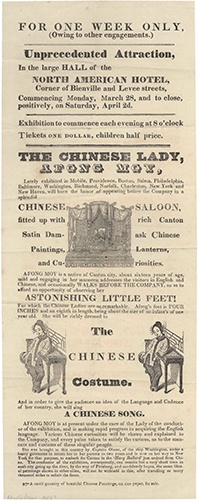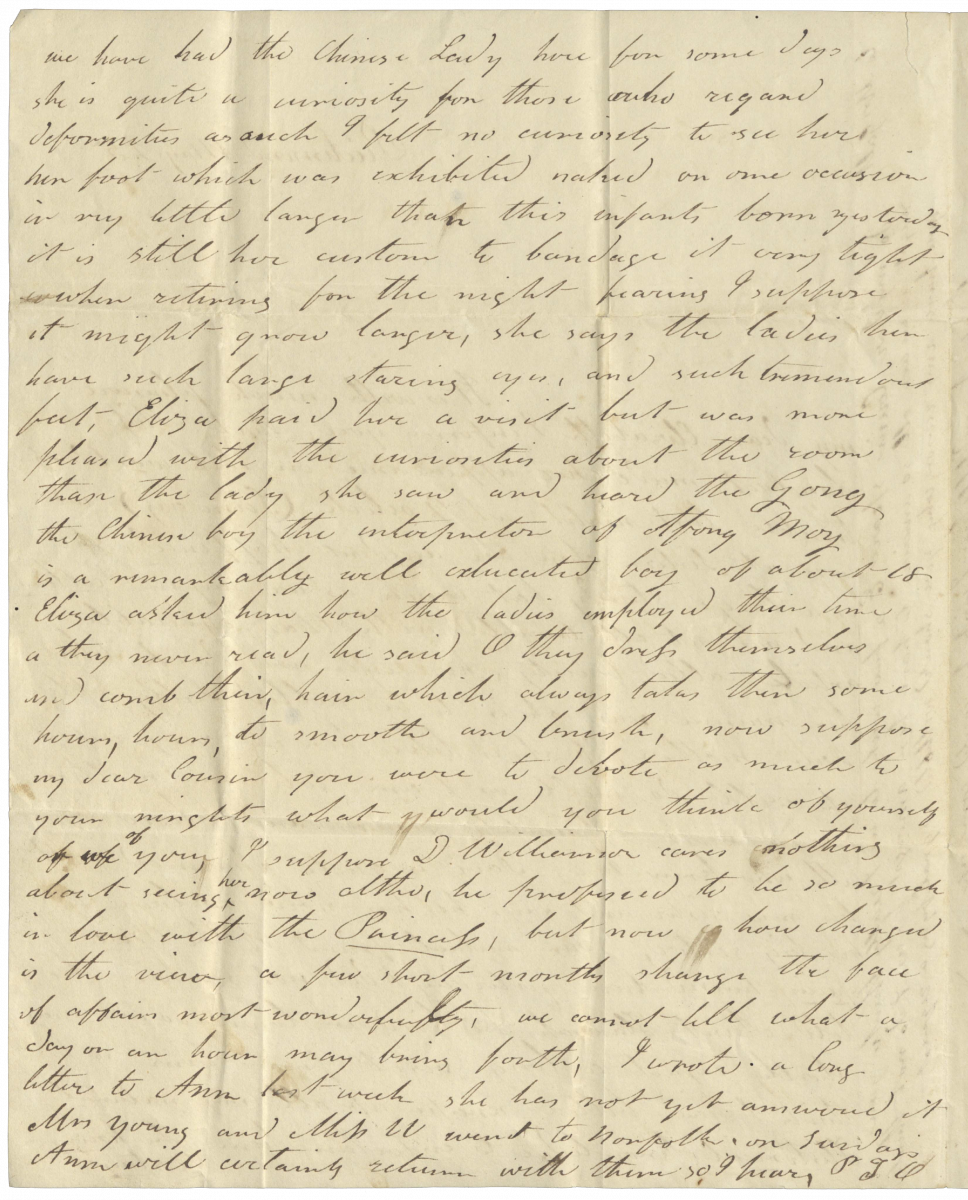By Yasmeen Raffee, M.A. Student in History and 2021-2022 Graduate Student Apprentice in Special Collections
 Broadside from circa 1842 advertising the exhibition of Afong Moy in New Orleans. From the W&M Libraries database, American Broadsides and Ephemera, 1749-1900
Broadside from circa 1842 advertising the exhibition of Afong Moy in New Orleans. From the W&M Libraries database, American Broadsides and Ephemera, 1749-1900On the 17th of October 1834, a fourteen-year-old Chinese girl arrived on the shores of New York City. The ship’s passenger list included her name as “Auphmoy” which was later phonetically shortened to Afong Moy—because of this, we do not know her real Chinese name. She came from Canton under the sponsorship of two merchants, Nathaniel and Frederic Carne, who ran a business importing Chinese goods to the American market. They felt that Afong Moy, with her traditional dress and bound feet, would be a valuable marketing tool for selling their imported wares. So began Afong Moy’s story as the first known female Chinese immigrant to the United States.
However, Afong Moy herself is obscured in shadow. ‘Agency’ is a buzzword that bounces around in historiographies of the subaltern, to use the terminology of G.C. Spivak, but the story of Afong Moy is distinctly devoid of her own voice and decisions. We know little about how exactly she came to arrive in the U.S., but it was most certainly not her decision alone. In her book, The Chinese Lady: Afong Moy in Early America, historian Nancy E. Davis posits that Afong Moy was probably the daughter of a local Cantonese merchant with conceivably enough status to support a daughter with bound feet, who thus could not work to help support the family.
For the rest of her known life, Afong Moy was exhibited across the United States and possibly Europe. The Carne brothers, her first managers, surrounded her with imagined orientalist backdrops in order to help sell their wares. Later in her life, management of Afong Moy as a public figure was passed along to the infamous P. T. Barnum, a great exploiter of otherness, where she was again used to titillate the Orientalist fantasies of the American public.
 Sally Lambert writes, "She [Afong Moy] says the ladies here have such large staring eyes, and such tremendous feet. Eliza paid her a visit but was more pleased with the curiosities about the room than the lady she saw." Letter, Sally Lambert, Richmond, to Elizabeth Galt, Williamsburg, 1836 May 25, Galt Papers (I) [Scan and transcription of letter available in the William & Mary Digital Archive.]
Sally Lambert writes, "She [Afong Moy] says the ladies here have such large staring eyes, and such tremendous feet. Eliza paid her a visit but was more pleased with the curiosities about the room than the lady she saw." Letter, Sally Lambert, Richmond, to Elizabeth Galt, Williamsburg, 1836 May 25, Galt Papers (I) [Scan and transcription of letter available in the William & Mary Digital Archive.]After 1850, Afong Moy all but disappeared from public record; she may have gone to Europe, or may have retired. We may never know. Although her legacy lives on as the first known Chinese female immigrant to the United States, we know nothing about her personality. We know nothing of her appearance, besides some illustrations made of her exhibitions and descriptions from some patrons who visited, including a letter in W&M Libraries’ Special Collections Research Center. We know nothing of what she thought of the United States, or how she felt about being displayed, objectified, and fetishized for profit.
However, there have been attempts to fill in the gaps. Playwright Lloyd Suh wrote a play entitled The Chinese Lady to do just that. At just ninety minutes in length with no more than two characters on stage for the entire play, The Chinese Lady is a fictionalized reimagining of Afong Moy’s life in America, which recenters her as the narrator of her own story. The character of Afong Moy reclaims her agency as she tells us (the audience) exactly how she feels about being a traveling exhibit. The play is at times both heartrending and darkly funny, but overall reminds us of the humanity of forgotten voices such as that of Afong Moy.
Afong Moy’s cavernous archival silence is representative of marginalized peoples in the archives. Not only was Afong Moy a woman, but she was also a Chinese immigrant, which served to compound the absence of her voice in the historical record. Afong Moy’s American world was, from the very first, framed by a stage. Here, as Nancy E. Davis writes in The Chinese Lady: Afong Moy in Early America, "objects, images, clothing, and Afong Moy herself provided the setting for a narrative that others scripted.” This same story is replicated over and over by innumerable women, regardless of their race or the era in which they lived. Although women’s voices have been stifled in the historical record, that does not necessarily mean they are completely missing; we just have to look a little harder to find them.
William & Mary's Asian Centennial and Theatre Program will present The Chinese Lady by Lloyd Suh, based on the life of Afong Moy, at the Williamsburg Regional Library on April 3. More information is available on the W&M Events page and WRL website.